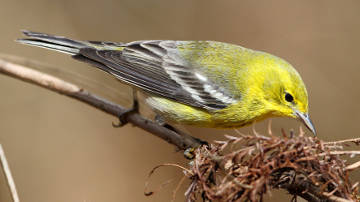

PHOTO COURTESY OF GARRY KESSLER
Pine warblers have returned to the area on schedule.
May 4, 2018, Page B4
NATURE NOTES
By Annie Reid
Westborough Community Land Trust
Pine warblers arrive on schedule
Spring is late this year, but one of “our” warblers has been appearing pretty much on schedule in April and into May: the pine warbler. Some pine warblers come to stay for the breeding season in Westborough and neighboring towns, although others just pass through on their way farther north.
The name pine warbler (Setophaga pinus) is a big hint that the best place to look and listen for these birds is near pine trees. Pine warblers feed, sing, breed, and nest in pines.
Be on the lookout for pine warblers in the native eastern white pines (Pinus strobus) that are common in our local natural landscape. These tall pines have spreading horizontal branches and long soft needles growing in clusters of five. In other environments where different pines are typical, pine warblers frequent other pines. On Cape Cod, for example, you’ll find pine warblers in the pitch pines (pinus rigida) that grow in sandy and coastal environments.
During their travels in migration season, pine warblers don’t always stick to pine trees. This can be a good time of year to spot one in the bare branches of trees or shrubs, and at lower heights.
Yellow is the main color you’ll glimpse on pine warblers, but it’s generally not a flashy yellow. These birds are yellow on the head and chest, but their back is olive. Their wings are gray with two white wing bars. This color scheme works well as camouflage. Females are paler than males.
To find a pine warbler, listen for its song, especially when you approach white pines. The typical song is a trill – the same note repeated rapidly for a few seconds. Of course, other birds also sing trills, especially chipping sparrows (Spizella passerina), which are common around houses and yards but may also spend time in white pines. The pine warbler’s song is more musical and doesn’t usually have the dry, almost mechanical sound that the chipping sparrow’s trill often has. So if you hear trilling in pine trees, try to spot the bird. It might be a pine warbler. (Chipping sparrows are gray-brown with stripes and a rusty cap – no yellow.)
What do pine warblers eat? As with other warblers, they consume mainly insects (and spiders). But pine warblers have a heavier bill than many other warblers, which are often notable for needle-like bills. Thanks to their heavier bill, pine warblers can also eat pine seeds (which form in pine cones), as well as fruits and berries, especially in fall and winter. Pine warblers sometimes even come to bird feeders for seeds or suet – something you probably won’t see other warblers doing.
Why do pine warblers come here earlier than so many other warblers, which we typically see in May? The easy answer is that pine warblers winter primarily in the southeastern U.S., so they don’t have as far to travel as other warblers that winter in Central or South America.
Another part of the answer is that pine warblers eat a more varied diet, thanks to their heavier bill. They don’t have to wait until insects become abundant as trees blossom and leaf out. But you may notice that pine warblers are just as fond of juicy caterpillars as other warblers are.
A few other warblers also tend to be “early birds,” appearing in our area in April and early May. Besides pine warblers, you might see palm warblers (Setophaga palmarum) and yellow-rumped warblers (Setophaga coronata) in the bare woods of spring. Enjoy them all, and the others yet to come in May!